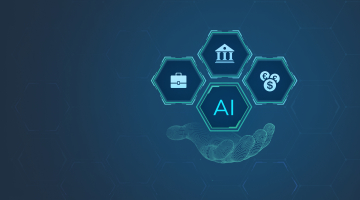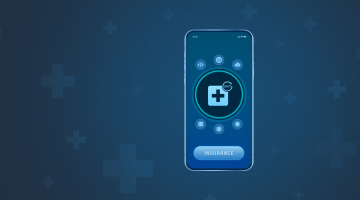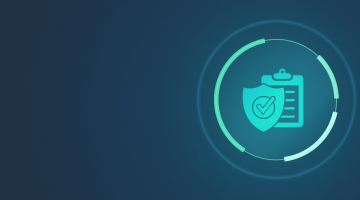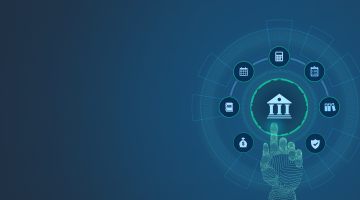

How does IoT impact to the insurance industry: Benefits and examples
How significant is the Internet of Things (IoT), for instance? Let’s look at numbers. Experts from IDC forecast that global spending on IoT will reach $1 trillion by 2022. And the insurance sector will feature the highest five-year CAGR among all industries – 17.1%.
What does this mean? Just IoT ideas are disrupting the insurance markets quickly and inevitably. Today, various companies already gather data from connected devices to simplify claims management and deliver more personalized services. Further, the role of IoT will only grow, forcing underwriters to evolve to remain competitive.
If you represent this industry, you may wonder how to catch the wave. DICEUS will guide you through all the basics, show significant IoT benefits, and reveal the top challenges for IoT in insurance. Of course, thanks to our professional background in insurance combined with advanced technologies, we can help design safe and profitable IoT-driven insurance software.
Without further ado, let’s begin.
IoT and the digital age in insurance
First things first, we should understand IoT clearly. Put simply, this term refers to a system of interconnected elements: sensors, computing programs, machines, items, and even people. All of them can exchange data directly, forming a new type of network that doesn’t require a human operator to control everything.
It’s possible that you don’t trust in the bright future of IoT. That’s typical for businesses. But it’s also dangerous to refuse to accept modern trends. According to Statista, there will be 75.44 billion connected devices in 2025. Compare this with 26.66 billion in 2019, and you will get almost triple growth. Of course, it will affect the insurance market, as well. People will use these gadgets to equip their homes and cars, generating valuable data for your business.
Since 2008, there have been more IoT things than people in the whole world. And they increase in number way faster than we do. Three essential factors support this growth:
- Connectedness. People tend to use innovations and connected solutions, particularly. They appreciate the convenience brought by these technologies.
- Data. Sensors regularly collect new information about customers and the world. This trend enables the growth of big data strategies that are vital for modern businesses.
- Power. According to Moore’s law, IoT gadgets (as well as other computing systems) can increase their power exponentially. This is true for the number of devices, too.
Planning to upgrade your system? Consider insurance claims management software development services.
The Internet of Things enables new opportunities for insurers who are ready for changes. Thanks to next-gen data processing principles, this technology allows getting market insights unattainable earlier. Innovations open ways for new business models. Moving further, let’s look at these strategies, as well as the benefits enabled by IoT nowadays.
Internet of things in insurance today
When it comes to the current situation in the insurance industry, we want to refer to Ben Luckett, Managing Director at Aviva. He says that markets are quickly changing now. Previous generations considered insurance as an inevitable evil, outdated, and blinkered. But technologies change everything, even in traditional ecosystems.
Mr. Luckett insists that the growth of IoT with the idea of ubiquitous connected sensors increased the amount and quality of data – a core resource for any Internet of Things insurance team. As a result, these changes drive significant shifts in business models. While there are different approaches to evolution, Aviva expert focuses on two Internet of Things trends in the insurance industry:
- From historical to real-time data. Insurers have to learn how to process almost unstoppable streams of data. By understanding real-time data, they can deliver more personalized products that lead to win-win interactions between businesses and clients.
- From responsive to predictive services. Thanks to real-time streams, insurers also should be able to understand customer needs better. From preventing road accidents to diagnosing illnesses early, predictive services can boost mutual satisfaction.
Keeping these points in mind, let’s talk about the advantages that IoT strategies bring to the insurance industry and the challenges to overcome. It’s crucial to know both the positive and negative sides, so you will be able to develop your business correctly. As well, this information can help in getting more tailored programs for your company.
If you want to learn more about modern insurance, check out the guide in our blog. It unveils the hottest trends in insurance software development for the next two years.
Benefits of IoT product insurance
In a nutshell, digital-driven operations allow underwriters to cut costs and maximize revenue. Surely, they must implement innovations properly to get these benefits. Here are the key advantages of implementing IoT in insurance:
- Generate extra revenue. The exact causes of this benefit include next-gen direct customer interaction with more personalized offers, the development of new services based on advanced insights, and optimization of prices tailored to demand.
- Reduce unnecessary expenses. These examples include increased efficiency that relies on automated prevention methods, improved safety with new standards like automated real-time reactions, and sensor-based analytics to prevent fraud.
Apart from costs and income, parties that use IoT devices for insurance can manage risks. For example, car insurance companies have direct data from vehicles, e.g., speed and driving behavior. Thus, they can evaluate the risks of accidents better and provide more tailored policies. The same is true for healthcare, where wearables help to monitor patients’ parameters 24/7.
Top challenges for IoT in insurance
Still, the implementation of IoT in insurance isn’t a cakewalk. It requires a lot of time and resources to prepare, get the required software, and transform operations. We don’t see the widespread adoption of the Internet of Things in the insurance industry because of several critical challenges. It’s vital to overcome them to start building new-age insurance. Here they are:
- Business models. IoT can disrupt traditional ways of doing business. Together with benefits, insurers will face a slight revenue decrease in the beginning. Thus, they have to find new services based on IoT and focus on clients, not companies.
- Data management. Even existing businesses often fail to process key data they receive. With the rise of real-time streams, this task will become more complicated. To deal with the issue, insurers have to invest in new enterprise strategies and tools.
- Data ownership. As for now, there is no answer to the problem of data ownership. Customers think that they should control data recorded by their sensors. Insurers believe that they also have rights. This issue has yet to be resolved.
- Data security. Of course, with the growing number of connected gadgets that collect valuable info, we will see more frauds and hackers. For insurers, this process marks the importance of perfect cybersecurity systems that can protect users.
- Regulations. Challenges related to data ownership, privacy, and processing result in a heated debate. Today, governments can regulate this industry, so let’s remember about standards and laws related to IoT.
These challenges prevent many insurers from diving into innovations. But it’s still possible to transform your business. With the professional help of domain experts and talented software developers, digital/IoT evolution goes much smoother.
Top connected ecosystems for insurers
Moving further, we also want to share with you some insights unveiled by McKinsey researchers. Based on the emerging Internet of Things trend in the insurance industry, digital disruptions, and the overall popularity of insurance services, it’s possible to name four major ecosystems that hide an enormous potential. They differ by maturity, dynamics, customers, competitors, and regulatory challenges. Let’s see how the Internet of Things insurance companies operate!
1. Connected health
This is a well-known industry that is rising thanks to wearables as the main IoT application for life insurance. Personal IoT gadgets help to monitor patient conditions constantly by delivering priceless insights. Doctors can now check way larger data packages, so they can identify diseases faster and prescribe more effective treatments. Thanks to tools like Verisense by Shimmer, people can get a small gadget and predict severe illnesses like cancer before they become incurable.
Thanks to personal and corporate IoT systems, insurers get better vision, too. They can identify health-related risks to offer the demanded products. In combination with smart household solutions, connected health gadgets also open a whole new industry – ambient assisted living. It helps aged people in their everyday lives. Underwriters deliver bundles of tailored services and even can act as healthcare curators who drive hospital-at-home interactions.
Considering custom solutions? Learn more about insurance mobile app development.
2. Connected vehicles
Today, cars are boxes full of electronic sensors. These gadgets monitor almost everything, from speed to pressure to wear of various details. If a driver has personal devices like smartphones or wearables, he/she also becomes a part of this local system. A-and, you got it. All these sensors produce telematics data. This information can be gathered by insurers in real time to optimize claims management, handle risks, and offer better products for each given customer.
It’s highly likely that with the rise of connected cars, insurance companies will face a decline in claim frequency with the simultaneous increase of claim sums. But this will lead to a revenue decrease, as well. That’s why insurance businesses have to think about new sources already. Applications of IoT in car insurance include work with workshops, service add-ons, risk management services, and other intelligent systems like parking and so on.
Insurance risk management software development services can help you improve risk assessment processes.
3. Commercial lines
Apart from personal interactions, insurers can always work with businesses. This B2B approach will undoubtedly flourish thanks to IoT. The catch is that corporations are interested in all-in-one solutions or policies that protect companies all the way along the supply chain. Here are the most notable parts of this journey:
- Planning. It’s especially valuable for innovative digital-oriented firms. For them, IoT-powered underwriters can offer next-gen cybersecurity services.
- Manufacturing. Various sensors can be installed in factories and plants. They predict accidents, help to get data to optimize processes, and boost worker experience.
- Warehousing. As well, insurers can process info from sensors in storage. They will help to assess risks and set better prices for corporate insurance.
- Sales. Again, IoT can enable better risk management. For example, capital-to-risk matching provides for the trading of insurance securities and transferring risks.
- Distribution. Fleet management is essential for all companies that deliver goods. In this case, insurance ideas for connected cars work fine.
Planning to add some features to your system? Learn more about the insurance agency management software development.
4. Smart homes
This ecosystem is probably the most famous. In recent years, software/hardware developers such as Google, Samsung, Amazon, and Apple have presented dozens of smart home solutions for the mass market. Today, almost every citizen can purchase a smart camera, a leakbot, and even smart appliances. All these gadgets are integrated thanks to cores – virtual assistants or smart home hubs that control other devices.
Insurers get significant benefits from this growing industry. They can collect data from thousands of thousands of households, process it, and identify risks for each property. Based on this analysis, they create custom policies. Many insurers tend to sell integrated products via smart assistants. They also create new services like improved protection from leaks or higher convenience for owners of smart homes.
How to improve your IoT-driven services
To start a successful IoT product insurance project, it’s not enough to get a reliable solution and connect to sensors. There are a few steps required to make the best insurance IoT system:
- Define customer needs with exact application areas.
- Ensure that the systems are scalable and can work with Big Data.
- Increase the delivery speed regardless of the services’ complexity.
- Look at long-term strategies with global reach.
- Set strategic partnerships as early as possible.
Carrie Lonze from Accenture says that modern insurers should think about a new approach – the Internet of Thinking. According to insights, unique insurance ecosystems will be based on edge architecture that provides for data processing and analysis via sensors, not central servers. The main reason is the growing amount of data.
Also, Lonze also notes that some companies have made significant progress in automated processing thanks to edge computing. For example, a startup called Aerobotics uses satellite imagery to predict crop health. More traditional groups like Allianz France use constant monitoring of construction sites to predict various risks.
Move ahead with DICEUS
Whether you’re only thinking about the Internet of Things insurance ideas or already have a plan, don’t hesitate to contact us. We have rich experience in this field, with a few notable solutions developed, i.e., Benefitnet and Insubiz. Our experts can help with all stages of software development, from the first consultation to proof of concept projects to launch and support. We care about innovations and like to be involved in game-changing activities. Let’s work together!





